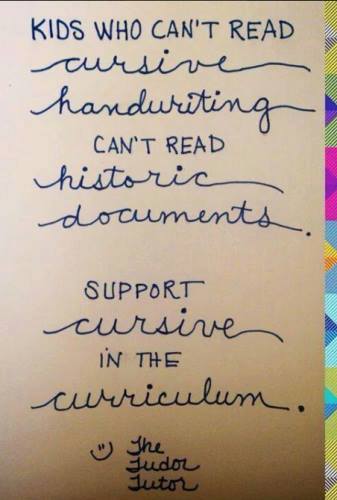My son got mail from his grandparents recently.
“What did Mimi and Pappy say in their card?” I asked, expecting an enthusiastic response.
“I don’t know, Mom. It’s in cursive.”
Therein lies the stark reality – kids do not read and write in cursive as they once did. Some would argue there is no need to do so. In our technology-on-steroids society, cursive seems a thing of the past; a useless relic of a bygone era. Also, given all that a child needs to learn today, is it really necessary to add cursive writing to the already jam-packed docket?
But before proclaiming Death to Script!, it would be worthwhile to examine some reasons as to why cursive writing should continue to have a place in modern pedagogy.
1. Being able to read documents from other generations
Not only sweet messages from Grandma, but also many documents of historic import were written in long hand. Learning to write cursive enables you to read cursive. Imagine the difference between learning about the Declaration of Independence and reading it for yourself. You can’t read if for yourself if you don’t know cursive.
2. Learning cursive encourages fine motor skills.
The slant and formation of the letters and the fluid style is different from printing. Learning this new skill gives opportunity to practice and improve fine motor skills.
3. Perseverance
As with learning any new skill, learning to write cursive requires perseverance. In this age of instant gratification, having something that doesn’t come immediately is a welcome change. Repeated practice in shaping letters can also shape our character.
4. Sign here.
How can you have a respectable signature if you’ve never learned cursive? Even the most indecipherable scrawl has its basis in longhand.
5. Level of sophistication
I love reading letters from my French friends. They have that distinctive handwriting of someone went to school in Europe. No way around it – your handwriting says something about you. Having good cursive penmanship speaks to your sophistication and level of education.
6. Artistic appreciation
Inherent in cursive writing is a sense of balance and a sense of symmetry unique to this form of writing. Taking the time to learn cursive helps to train the eye to recognize artistic expression.
7. Stance against tech takeover
Of course I can’t deny the incredible ease that technology has brought to word craft. However, in our point-and-click world, I find it satisfying to pick up a pen and produce something on paper that doesn’t require software, RAM, or even electricity. It’s refreshing, in my opinion. It fosters a connection with the host of humanity before me who have expressed themselves similarly.
8. Hand-eye coordination
As students learn cursive, it is yet another opportunity to look at something and reproduce it manually. This repetitive exercise strengthens coordination.
9. Fluid movement
Most styles of printing consist of lifting the pencil off the paper for starts and stops, sticks and circles. Cursive lends itself to a more fluid movement. Some children who struggle with printing find longhand a more natural alternative.
Will we say goodbye to cursive? I hope not. I hope there will always be someone who seeks to grace a piece of paper with that beautiful art form we call cursive. Let’s teach our kids to that end!
